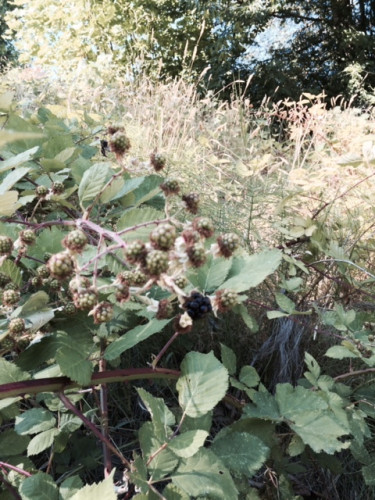Himalayan blackberries are invasive in the Seattle area. The canes seem to sprout out of nowhere and grow almost as fast as kudzu in the Carolinas. Not only do they grow fast, they bear mass quantities of fruit from July to October. Birds consume the berries and spread the seeds in their waste, which produce more canes. Homeowners spend lots of time and money trying to rid their yards of these invaders. However, I have devised a simple way to prevent further invasion of Himalayan blackberries—pick them and eat them.
One of my favorite summer pastimes when I lived in upstate New York was picking wild blackberries and raspberries on my grandfather’s farm. I’d have to do a good bit of walking and endure lots of scratches to get enough berries for a cobbler or pie. My part-Labrador retriever, Lucy, would accompany me. She’d graze the lower canes while I worked the upper ones. Occasionally my mother’s basset hound, Clementine, would join us. She had to settle for the few berries that grew at her level, regardless of their stage of ripeness. One summer my 20-pound cat, Shamus, brought up the rear of this bizarre parade. He was more interested in keeping the dogs behaved than eating berries. (Shamus took no guff from dogs—he once rode a German shepherd out of the yard.)
When we lived in Seattle, the most accessible Himalayan blackberry patch was at the end of our street. I could pick a quart of berries there in less than 30 minutes without breaking a sweat. The Burke-Gilman and Sammamish River Trails also have large areas of berry canes. I suspect the berry-pickers hereabouts are more avian than human. This is a shame, because blackberries are tasty and have high nutritional value. According to my trusty 17th edition of Bowes and Church’s Food Values of Portions Commonly Used (Lippincott, 1998), ½ cup of blackberries contains more dietary fiber than the same amount of other fresh fruits and a good amount of potassium. High dietary intakes of potassium may reduce the risk of high blood pressure. In addition, the chemicals that give blackberries their color may be helpful against the development of cancer. Suddenly these invaders don’t look so evil after all.
When you pick Himalayan blackberries, remember that there is no gain without pain. Those canes are armed with thorns. It’s a good idea to wear jeans and a long-sleeved shirt to pick enough for pie. Go for the berries that are solid black and come away from the stem easily. If you have to work to pick a berry, it’s not ripe yet. Blackberries and raspberries are very perishable. This is why you pay $3 for a mere half pint of them at the grocery store in July. Plan on using or freezing your harvest within two days of picking. Don’t store them in a deep bowl, as the bottom berries may get crushed. Wash them just before you use them to reduce the risk of mold.
So what can be done with Himalayan blackberries besides eating them directly off the canes? You can serve them in a fruit salad or over ice cream. You can make ice cream or sorbet with them. Throw a few of them into a fruit smoothie. We are fond of them in cobblers and crisps. Any general cookbook will have a recipe for one of these. It’s best to find a recipe that doesn’t cook the berries before baking, as this can cause them to fall apart. They can also be made into jellies and preserves. Some of these recipes require forcing the juice through a fine sieve or food mill to remove the seeds. You can also freeze them for cobblers in January. Spread the unwashed berries in a single layer on a baking sheet, freeze them solid, and then package them in zipper bags for long-term storage.
Another fine way of dealing with a bumper crop of Himalayan blackberries is to share them with neighbors and friends. Just look upon it as another way to halt the invasion. Before long, you may have human competition at the local berry patch.


1 comments
I also used to wander out in the fields picking wild blackberries accompanied by my dog. One beautiful memory was watching the full mood rise up and light my way back home. I’d pick a bucket full and bake cobblers. Nothing better than warm berry cobbler with vanilla ice cream.
There are tons of wild raspberries where I live now, however they’re guarded by ticks so I only pick the ones I can reach from the roadside. We’re trying to stick to a semi diet so cobblers and ice cream are out. I eat them immediately or save some for Scott’s morning oatmeal.